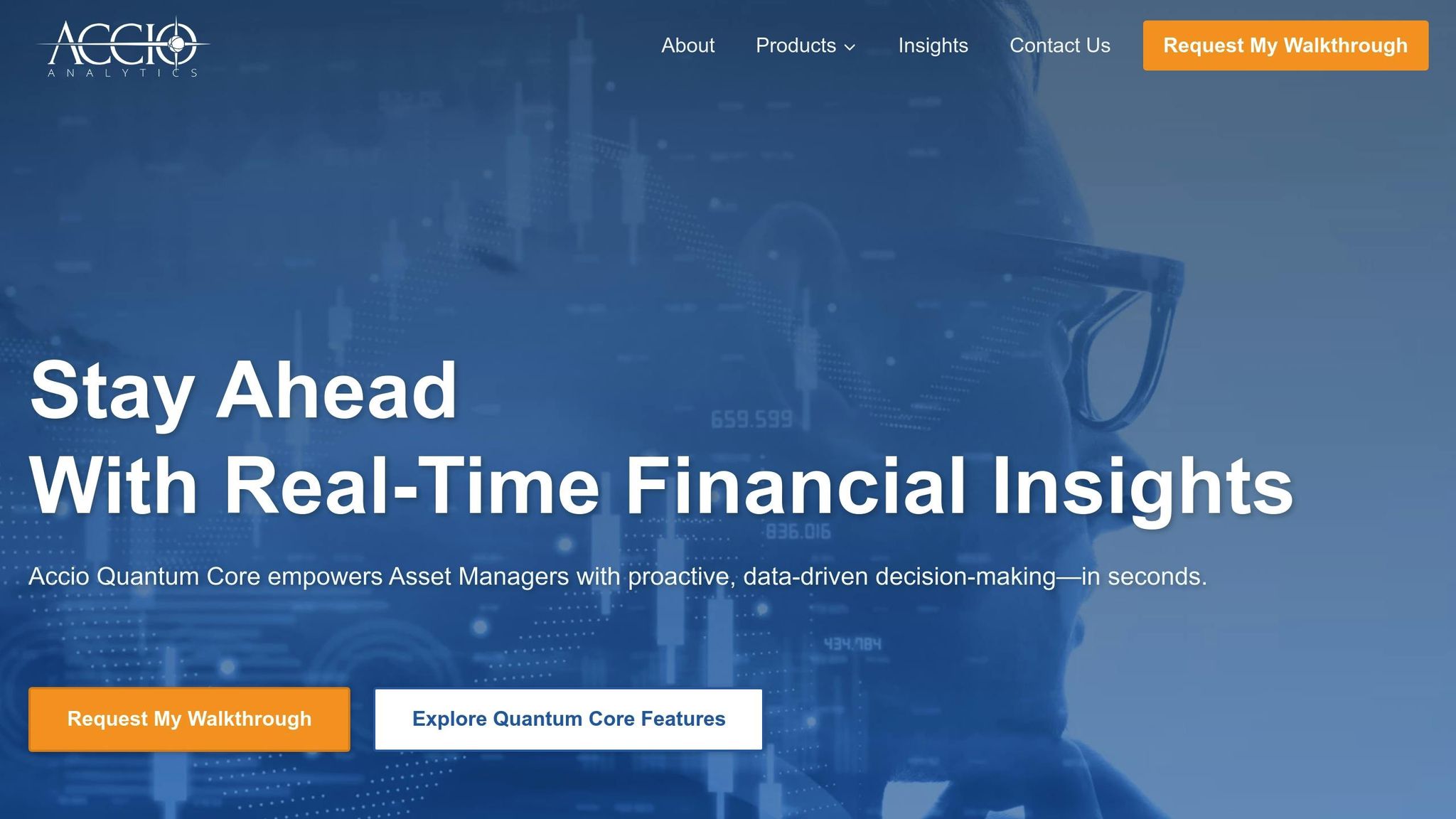The Silent Killer of Innovation: Calculating the True TCO of Your Legacy Data Infrastructure
Accio Analytics Inc. ● 13 min read
Legacy systems are more than outdated technology – they’re a hidden drain on your budget and a roadblock to growth. For financial institutions, the Total Cost of Ownership (TCO) goes far beyond hardware and software expenses. It includes inefficiencies, compliance challenges, and missed opportunities that can quietly erode your competitive edge.
Key Takeaways:
- Hidden Costs Add Up: Beyond maintenance, legacy systems create staffing challenges, technical debt, and higher compliance risks.
- Security Risks Are Growing: Outdated systems are vulnerable to breaches, increasing costs for mitigation and cyber insurance.
- Missed Revenue Opportunities: Without modern tools like AI or real-time analytics, firms lose market share and fall behind competitors.
The Bottom Line: Legacy systems aren’t just expensive – they’re holding your organization back. By understanding the true TCO, you can build a clear case for modernization and position your firm for future success.
This guide breaks down the hidden costs, risks, and business challenges of legacy infrastructure and outlines actionable steps to calculate TCO effectively.
Breaking Down the True TCO of Legacy Systems
When evaluating the financial impact of legacy data infrastructure, it’s crucial to look beyond the surface-level expenses. The true cost extends across several categories, creating a financial strain that financial institutions often underestimate.
Direct Operating Costs
At first glance, direct expenses like hardware and software maintenance seem straightforward. But as systems age, maintaining them becomes increasingly expensive. Hardware repairs become more frequent, and sourcing parts or finding technicians familiar with outdated systems often comes at a premium.
Software licensing is another area where costs escalate. Legacy systems frequently require costly annual maintenance contracts, and their inefficiency drives up energy consumption, further inflating operational costs. These visible expenses, however, are just the tip of the iceberg – hidden costs can be even more damaging.
Hidden Costs: Staffing and Technical Debt
Staffing represents a significant hidden expense. As legacy systems grow obsolete, finding professionals with the expertise to manage them becomes harder and more expensive. Specialists in older technologies often command higher salaries than those working with modern systems.
Training new hires to operate outdated architectures is another challenge. The steep learning curve prolongs onboarding and reduces productivity. Over time, technical debt compounds as quick fixes and patches accumulate, leaving systems fragile and prone to failure. Routine updates can spiral into large-scale projects requiring extensive testing and coordination, slowing innovation and development while driving up costs.
These operational challenges are compounded by regulatory and security risks.
Compliance and Security Risks
Legacy systems often struggle to meet modern regulatory requirements. Many regulations now assume capabilities like real-time data processing and advanced analytics, which older infrastructures typically cannot support. To comply, institutions may need costly workarounds – or risk fines and penalties.
Security is another major concern. Outdated systems lack modern encryption and authentication protocols, leaving them vulnerable to breaches. Unpatched security flaws and outdated data formats complicate audits and compliance reporting, requiring additional resources to meet regulatory standards. These vulnerabilities not only increase costs but also expose institutions to reputational harm.
Missed Opportunities and Lost Revenue
Legacy systems don’t just cost money – they also limit growth. Without support for modern tools like advanced analytics, artificial intelligence, or machine learning, financial institutions miss out on opportunities to gain a competitive edge.
Infrastructure limitations can delay the launch of new products or services, leading to lost market share. Additionally, the inability to deliver real-time personalization risks losing existing customers and makes it harder to attract new ones. Legacy systems also hinder initiatives like data monetization and advanced risk modeling, capping revenue potential and stifling innovation.
The financial and operational burdens of legacy systems go far beyond their visible costs, impacting everything from compliance to customer retention and growth opportunities. These systems may once have been assets, but today they often act as barriers to progress.
How to Calculate the True TCO of Legacy Data Infrastructure
Understanding the Total Cost of Ownership (TCO) of legacy systems goes beyond just tallying visible expenses. It requires a thorough approach that uncovers hidden costs and provides financial institutions with a clear view of their infrastructure’s economic impact. This clarity is key to making informed decisions about modernization.
Step 1: Inventory and Map Dependencies
Begin by taking stock of all your legacy systems. Catalog every hardware component, software application, database, and network element. Note down details like system age, vendor information, maintenance agreements, and how each system is currently used.
Map out data flows, API connections, and integration points to identify problem areas. Pay special attention to systems that act as bottlenecks or single points of failure – these often carry higher risks and could inflate replacement costs.
Creating a visual dependency map can be particularly useful. It shows how systems interact and highlights which business processes depend on each component. This map not only helps uncover the full scale of modernization efforts but also aids in prioritizing which systems to address first. With this groundwork, you’ll be ready to calculate both direct and indirect costs.
Step 2: Calculate Direct and Indirect Costs
Direct costs are usually the easiest to quantify. Combine expenses like hardware maintenance contracts, software licensing fees, data center space, and utility costs for power and cooling. Don’t forget to include the cost of backup systems, disaster recovery setups, and any premium pricing for hard-to-find replacement parts for older equipment.
Indirect costs, while less obvious, are just as important. These include staff hours spent on maintenance, training expenses, consulting fees, and delays caused by technical debt. Together, these costs paint a more complete picture of the financial burden of legacy systems.
Step 3: Assess Compliance and Security Costs
Legacy systems often bring higher compliance costs as regulations evolve. Calculate the extra time staff spend manually preparing compliance reports when automation isn’t available. Factor in the cost of external audits that may be required to meet updated standards.
Security is another major consideration. Aging systems often require additional tools, monitoring software, and specialized personnel to address vulnerabilities. Include the ongoing costs of applying patches or implementing temporary fixes when vendor support is no longer available.
To estimate potential breach costs, consult industry reports. These should include expenses like fines, legal fees, and reputational damage. Also, consider how operating legacy systems may increase your cyber insurance premiums due to a higher risk profile. With these numbers, you can better understand how security and compliance challenges impact your overall TCO.
Step 4: Model Opportunity Costs
Legacy systems don’t just cost money – they can also limit revenue opportunities. Start by quantifying the losses caused by delays in product launches or inefficiencies in operations. For example, if manual processes slow down transaction times, calculate how this affects revenue generation.
Consider the missed opportunities from not implementing AI or machine learning technologies. Legacy constraints may prevent you from leveraging data-driven insights, which can lead to lost revenue and reduced customer satisfaction. Poor digital experiences, for instance, can drive customers to competitors.
sbb-itb-a3bba55
Business Risks of Maintaining Legacy Infrastructure
The challenges of legacy infrastructure go well beyond the direct financial impact. While Total Cost of Ownership (TCO) calculations highlight the monetary strain, the broader risks extend into operational inefficiencies and strategic setbacks. These outdated systems can expose organizations to vulnerabilities that hinder their ability to compete, adapt, and maintain stability in an increasingly demanding market.
Innovation and Performance Roadblocks
Legacy systems often act as barriers to innovation. Built for a time when data volumes and processing needs were far less demanding, they struggle to meet the requirements of today’s real-time operations. For instance, reliance on outdated batch processing delays critical insights, slowing down dynamic pricing, rapid risk analysis, and personalized services.
Efforts to integrate AI also face significant hurdles. Siloed and inconsistent data, coupled with processing delays, make real-time insights difficult to achieve. Older hardware further compounds the issue, creating bottlenecks that limit advanced analytics. Scalability becomes a major concern during peak trading periods or volatile market conditions. Institutions are left with two poor choices: over-provision hardware to handle rare spikes or suffer degraded performance when it’s needed most. These limitations not only affect operational efficiency but also increase reliability and compliance risks.
Increased Risk of Outages and Non-Compliance
As infrastructure ages, the likelihood of failures and outages grows. Hardware components often exceed their intended lifespan, leading to higher failure rates. System downtime can result in missed trading opportunities, frustrated customers, and even regulatory fines.
Compliance becomes another uphill battle. Regulations evolve rapidly, often assuming that financial institutions have modern systems in place. However, legacy systems struggle to keep up, forcing organizations to rely on manual processes that are both costly and error-prone.
Cybersecurity vulnerabilities also loom large. Older systems often lack essential safeguards like robust encryption, multi-factor authentication, or advanced threat detection. These gaps present easy targets for cybercriminals. In many cases, the fallout from a breach – whether financial, reputational, or operational – far outweighs the cost of updating the infrastructure. Such vulnerabilities don’t just pose operational risks; they also translate into competitive disadvantages.
Falling Behind the Competition
Organizations clinging to legacy systems often find themselves outpaced by competitors leveraging modern technology. For example, while some institutions can launch new products or services in weeks, those hampered by outdated systems may face months-long delays. This inability to move quickly can mean missed market opportunities and lost first-mover advantages.
Customer experience also takes a hit. Legacy systems often struggle to support the seamless, omnichannel interactions that today’s consumers expect. Features like mobile apps, real-time notifications, and integrated customer portals may be difficult – or impossible – to implement, leading to fragmented and frustrating user experiences.
Operational inefficiencies further widen the gap. Competitors using automation and AI can reduce costs and improve service speed, while organizations stuck with legacy systems must rely on manual processes that are slower and more expensive. Attracting top talent becomes another challenge, as skilled professionals increasingly prefer working with cutting-edge tools and platforms.
Ultimately, the strategic risks tied to legacy systems aren’t just theoretical – they manifest as real costs in the form of lost opportunities, higher expenses, and weakened market positions. These factors must be considered when evaluating the true cost of maintaining outdated infrastructure.
Building a Business Case for Modernization with Accio Quantum Core

Modernizing outdated systems is more than just a tech upgrade – it’s an opportunity to turn costly inefficiencies into strategic advantages. To make a strong business case for modernization, you need to translate the hidden costs of legacy systems into clear financial benefits. The focus shifts from viewing modernization as a hefty expense to understanding it as a smart, forward-thinking investment.
Tackling TCO Challenges with Accio Quantum Core
Legacy systems are notorious for draining resources. They demand high maintenance costs, rely on hard-to-find expertise, and accumulate technical debt over time. Accio Quantum Core addresses these pain points with its modular architecture, which reduces the need for expensive hardware upkeep and minimizes dependence on legacy specialists.
What sets it apart is its API-driven integration approach. This allows organizations to modernize step by step, avoiding the disruption and expense of replacing entire systems at once. For instance, specific agents like the Holdings Agent or Risk Exposure Agent can be deployed to solve pressing issues while still leveraging existing technology. This approach not only lowers implementation risks but also speeds up the time it takes to see tangible results. The streamlined integration enhances both system reliability and operational flexibility.
Accio Quantum Core also includes built-in validation and trace functionality, which cuts down on operational risks by eliminating manual processes prone to errors. Its dynamic processing capabilities replace outdated batch systems that require over-provisioned hardware to handle peak loads. By scaling resources based on actual demand, organizations can transition from fixed costs to variable ones, leading to significant savings.
Quantifiable Gains from Modernization
Switching to Accio Quantum Core delivers measurable benefits across critical operational areas. Real-time transaction processing eliminates delays caused by overnight batch reconciliations and reduces system downtime by replacing aging hardware with modern, reliable infrastructure. The platform’s parallel processing design ensures that even if one component fails, the rest of the system continues to function, maintaining availability during crucial times.
Scalability is another major advantage. Organizations can adjust processing power dynamically, cutting unnecessary costs, while employees can focus on strategic projects instead of maintaining outdated systems. Integrated agents, such as the Security Analytics Agent and Returns Agent, break down data silos, enabling faster decision-making. This empowers portfolio managers and risk officers to respond quickly to market changes with real-time insights.
Turning TCO Into a Competitive Edge
Modernization doesn’t just reduce costs – it transforms them into opportunities for growth. By converting fixed legacy expenses into flexible, strategic investments, organizations can redirect resources from maintenance and technical debt to innovation and product development. The modular architecture of Accio Quantum Core supports faster prototyping and deployment of new analytical tools, giving firms a competitive edge with shorter time-to-market cycles.
Customer experience also benefits. Real-time insights enable personalized services, dynamic pricing, and live portfolio monitoring through agents like Patrol, setting firms apart from competitors and allowing them to command premium value for their services.
Risk management evolves from being a cost center to a strategic advantage. For instance, the Risk Ex-ante Agent’s predictive capabilities help identify risks early, reducing potential losses and uncovering profitable opportunities.
Additionally, modernizing with cutting-edge technology can attract top talent. With less time spent on routine maintenance, technical teams can dedicate their efforts to innovation and efficiency improvements, making the workplace more appealing to skilled professionals.
Conclusion: Taking Action to Drive Progress
The financial services industry is changing fast, and outdated data systems are becoming a growing obstacle to forward momentum. The cost of maintaining legacy systems isn’t limited to monthly expenses – it also includes inefficiencies, compliance challenges, and missed revenue opportunities.
Total Cost of Ownership (TCO) isn’t just a financial metric – it’s a strategic tool. When you account for the hidden costs tied to legacy systems, the business case for modernization becomes undeniable.
Leading organizations aren’t waiting – they’re taking action now. By transforming fixed legacy expenses into strategic investments, they’re replacing slow batch processing with real-time insights and reimagining IT departments as drivers of growth and innovation.
A modern approach is the solution to these challenges. Accio Quantum Core offers a clear path forward, tackling the root TCO issues of legacy systems. Its modular design allows for step-by-step modernization, preserving existing investments while delivering immediate results. With API-driven integration that minimizes disruptions and specialized tools like the Holdings Agent and Risk Exposure Agent, firms can achieve measurable gains in efficiency and risk management.
The choice is clear: modernization isn’t just an option – it’s a necessity. Every day spent clinging to outdated systems is a day competitors gain an edge with faster operations, better customer experiences, and more innovative solutions. Firms that take a hard look at their TCO and act swiftly will be the ones shaping the future of financial services. Modernizing now secures your position ahead of the curve.
The time for legacy systems has passed – act today.
FAQs
What are the hidden costs of legacy data systems, and how can financial institutions calculate them?
Legacy data systems might seem like a reliable choice because they’ve been around for years, but they often come with hidden costs that can weigh down your business. These costs fall into two main categories: direct expenses and indirect costs.
Direct expenses include things like maintenance fees, licensing costs, and support contracts that can quickly add up. On the other hand, indirect costs are less obvious but just as impactful. Think operational inefficiencies, unplanned downtime, compliance risks, shadow IT (when employees bypass outdated systems with their own tools), and missed chances to drive growth.
So how do you measure the true cost of sticking with outdated systems? A Total Cost of Ownership (TCO) analysis is the answer. This process looks at both the upfront and ongoing expenses tied to the system over its entire lifecycle. By pinpointing inefficiencies and putting a dollar figure on their impact, financial institutions can clearly see the financial burden of legacy systems. This analysis also helps build a compelling argument for upgrading to modern data infrastructure, paving the way for increased efficiency and fresh opportunities.
What security and compliance risks come with using legacy data infrastructure, and how can they affect your organization?
Legacy data infrastructure comes with serious security risks. Outdated systems are far more susceptible to cyberattacks, including ransomware and data breaches. The financial impact of these breaches can be staggering, often reaching millions of dollars per incident, not to mention the long-term damage to your organization’s reputation.
Beyond security, legacy systems often struggle to meet changing regulatory requirements, putting your business at risk of non-compliance. This can result in hefty fines, legal challenges, and disruptions to daily operations. Combined, these issues don’t just slow progress – they leave your organization exposed to costly problems that could have been avoided.
What competitive advantages can organizations gain by modernizing their data infrastructure with Accio Quantum Core?
Modernizing your data infrastructure with Accio Quantum Core gives your organization the tools to thrive in today’s fast-paced market. By moving away from outdated legacy systems, you can cut down on inefficiencies, enhance data quality, and tap into the power of real-time insights. This shift supports quicker, more precise decision-making and equips your business to adapt swiftly to market fluctuations.
It also tackles the risks that come with aging systems – things like compliance issues, data silos, and unexpected downtime. With streamlined data operations powered by Accio Quantum Core, your organization gains the flexibility to capitalize on new opportunities and respond confidently to changing business needs.



